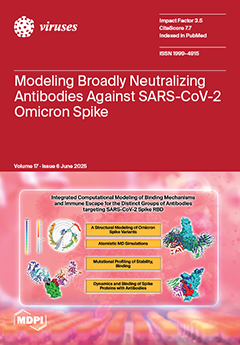Since its discovery via metagenomics in 2008, human cosavirus (HCoSV) has been detected in the cerebrospinal fluid (CSF) and feces of humans with meningitis, acute flaccid paralysis (AFP), and acute gastroenteritis. To date, 34 HCoSV genotypes have been documented by the
Picornaviridae study
[...] Read more.
Since its discovery via metagenomics in 2008, human cosavirus (HCoSV) has been detected in the cerebrospinal fluid (CSF) and feces of humans with meningitis, acute flaccid paralysis (AFP), and acute gastroenteritis. To date, 34 HCoSV genotypes have been documented by the
Picornaviridae study group. However, the documented genetic diversity of HCoSV in Nigeria is limited. Here we describe the genetic diversity of HCoSV in Nigeria using a metagenomics approach. Archived and anonymized fecal specimens from children (under 15 years old) diagnosed with non-polio AFP from five states in Nigeria were analyzed. Virus-like particles were purified from 55 pools (made from 254 samples) using the NetoVIR protocol. Pools were subjected to nucleic acid extraction and metagenomic sequencing. Reads were trimmed and assembled, and contigs classified as HCoSV were subjected to phylogenetic, pairwise identity, recombination analysis, and, when necessary, immuno-informatics and capsid structure prediction. Fifteen pools yielded 23 genomes of HCoSV. Phylogenetic and pairwise identity analysis showed that all belonged to four species (eleven, three, three, and six members of
Cosavirus asiani,
Cosavirus bepakis,
Cosavirus depakis, and
Cosavirus eaustrali, respectively) and seventeen genotypes. Ten genomes belong to seven (HCoSV-A3/A10, A15, A17, A19, A24, D3, and E1) previously assigned genotypes, while the remaining thirteen genomes belonged to ten newly proposed genotypes across the four HCoSV species, based on the near-complete VP1 region (VP1*) of the cosavirus genome. Our analysis suggests the existence of at least seven and eight
Cosavirus bepakis and
Cosavirus eaustrali genotypes, respectively (including those described here). We report the first near-complete genomes of
Cosavirus bepakis and
Cosavirus depakis from Nigeria, which contributes to the increasing knowledge of the diversity of HCoSV, raising the number of tentative genotypes from 34 to over 40. Our findings suggest that the genetic diversity of HCoSV might be broader than is currently documented, highlighting the need for enhanced surveillance.
Full article






